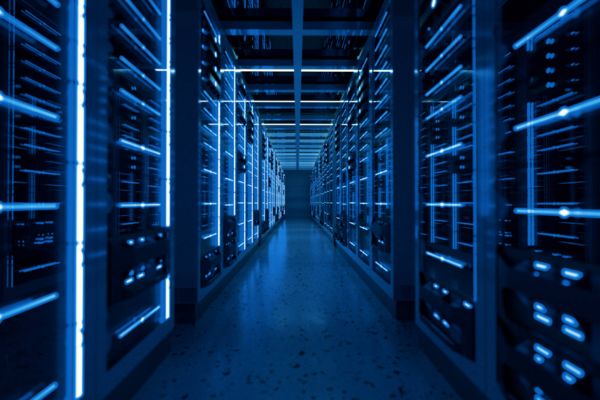The global data center market size is projected to surge around USD 481.73 billion by 2034 and is growing at a compound annual growth rate (CAGR) of 11.4% from 2025 to 2034. The data center market is experiencing robust growth, driven by the escalating demand for digital services, cloud computing, and scalable data storage across industries. This expansion is fueled by the exponential increase in data generation, largely attributed to the widespread use of IoT devices, the rise of online services, and digital transformation efforts globally. As data volumes surge, there is an urgent need for secure, efficient, and scalable storage solutions—pushing market growth further.
A key trend shaping the sector is the rise of edge computing, which enables data processing closer to the source, reducing latency and enhancing real-time performance. Simultaneously, the focus on sustainability is gaining momentum, with data center operators aiming to reduce energy consumption and carbon footprints. This shift is reshaping operational models and infrastructure investments.
The market is highly competitive, with major global players alongside smaller service providers addressing diverse customer needs. Offerings range from colocation and managed hosting to cloud infrastructure and hyperscale data centers. The sector’s future outlook remains strong, underpinned by ongoing digital transformation, the expansion of 5G networks, and advances in cloud technologies. However, overcoming challenges related to data security, operational efficiency, and environmental impact will be crucial for sustained growth.
Regional Developments
Asia and Europe are emerging as key growth regions:
- Southeast Asia, including countries like Singapore, Malaysia, and Indonesia, is witnessing rapid digital adoption, infrastructure development, and increased internet penetration. Government-backed initiatives are enhancing regional connectivity and innovation, making it a hotspot for data center investments.
- Europe is emphasizing sustainable data center operations. With strict regulations like the GDPR, there’s a growing demand for localized data storage. EU member states are also driving eco-friendly data practices, further shaping regional market dynamics.
In the United States, the number of data centers reached approximately 5,530 in 2023. These include both colocation and dedicated facilities, with major hubs in Northern Virginia, Dallas, Silicon Valley, Chicago, and New York. Data centers play a critical role in powering the U.S. economy, supporting cloud computing, e-commerce, artificial intelligence, and IoT applications. Continued growth is expected as demand for these technologies rises.
Key Market Drivers
1. Growing Demand for Digital Archive Storage
The need to store born-digital and digitized archives is significantly influencing market growth. The explosion of digital content—spurred by remote work and digital transformation—necessitates secure and scalable storage infrastructure. Cloud-based solutions have gained traction due to their cost efficiency and flexibility.
For example, cloud adoption in the U.K.’s public sector increased from 38% in 2010 to 78% in 2023, according to the Cloud Industry Forum. The total adoption rate now stands at 84%, highlighting a significant reliance on cloud technologies for managing digital archives across both public and private sectors globally.
2. Rise of Multi-Cloud and Hybrid Solutions
The global shift toward multi-cloud and hybrid cloud strategies is redefining the data center landscape. Organizations are increasingly leveraging multiple cloud providers to reduce reliance on a single vendor, enhance performance, and mitigate risks.
This approach offers improved flexibility, scalability, and operational resilience. For instance, companies commonly combine services from AWS, Azure, Google Cloud, and IBM Cloud to balance performance and avoid vendor lock-in.
At the same time, hybrid cloud models—which integrate on-premises infrastructure with cloud platforms—are gaining traction. A notable example is the U.S. Department of Defense, which blends internal data center infrastructure with commercial cloud services from Microsoft and AWS to support AI, analytics, and mission-critical applications. These strategies underscore a growing emphasis on flexible, optimized, and resilient cloud infrastructure.
Market Opportunities
Retail and E-commerce
The retail and e-commerce sector is one of the fastest-growing contributors to the data center market. These businesses rely heavily on data center services such as colocation, cloud hosting, cybersecurity, and analytics to support online platforms, payment processing, inventory systems, and customer engagement tools.
Digital transformation in this sector has accelerated, particularly in response to the COVID-19 pandemic, which drove a surge in online shopping and, consequently, data center usage. Retailers are increasingly adopting advanced technologies like AI, machine learning, and blockchain to enhance customer experience and maintain competitiveness.
As highlighted by Kayla Mathews, Walmart saw a 74% increase in e-commerce orders in Q1 FY2021, underlining the critical role of data centers in scaling to meet surging digital demands. Companies that prioritize exceptional customer service increasingly depend on data centers for uptime, reliability, and innovation.
In addition, big data analytics plays a foundational role in e-commerce success. Detailed consumer insights derived from data analytics inform product development, marketing strategies, and operational efficiencies. Leading platforms like Amazon continue to raise industry standards through data-driven decision-making and service innovation, reinforcing the importance of data center infrastructure.
Regional Analysis: Global Data Center Market Trends
Asia-Pacific: A Rapidly Emerging Data Center Powerhouse
The Asia-Pacific (APAC) region is fast becoming a critical hub in the global data center landscape. Growth is being driven by a combination of digitalization, urbanization, and rising demand across sectors like e-commerce, cloud computing, gaming, AI, and 5G. Enterprises and governments throughout the region are accelerating digital transformation and cloud adoption, thereby increasing the need for advanced data center infrastructure.
Tier 3 facilities currently dominate the region, offering robust support for cloud and edge computing applications. Meanwhile, Tier 4 data centers are on the rise to meet higher redundancy and uptime demands. Notable projects shaping the regional landscape include:
- AdaniConneX’s $213 million investment in India
- Equinix’s new data center in Tokyo
- HGC-Digital Realty’s collaboration in Singapore
These developments reflect a growing regional focus on infrastructure expansion, operational resilience, and performance optimization.
Innovation and Policy Support
The APAC market is also witnessing technological innovation with the rise of modular, green, and edge data centers. These solutions are gaining popularity for their energy efficiency, scalability, and speed of deployment. Governments in China, India, Singapore, and Australia are actively supporting the sector through favorable policies, tax incentives, and renewable energy integration initiatives.
Country Spotlight
China
China is the largest and most dynamic market in Asia-Pacific, driven by strong growth in cloud computing, e-commerce, AI, and gaming. The government’s “Eastern Data, Western Computing” initiative, launched in 2020, is central to China’s data strategy. This policy aims to redistribute computing power from the more congested eastern regions to the resource-rich west, supporting balanced infrastructure growth. Key data center clusters are being developed in:
- Jing-Jin-Ji
- Yangtze River Delta (YRD)
- Greater Bay Area (GBA)
- Chengdu-Chongqing
These initiatives are being guided by multi-year action plans and supported by regulatory approvals from bodies like the National Development and Reform Commission (NDRC).
India
India is rapidly becoming a key player in the APAC data center market. Government-led initiatives like the Draft Data Centre Policy 2020 emphasize affordable, clean energy and enhanced connectivity. Collaborative frameworks between MeitY and DoT aim to streamline connectivity, while data centers have been designated as essential infrastructure.
Supportive policies include:
- Integration under the National Building Code
- Designated data center economic zones
- Digital skill-building initiatives through DESH, NSDC, and MSDE
India’s digital transformation is further driven by national programs like Arogya Seva, mSevanam, and Ente Ration Card, boosting demand for localized data processing and secure storage.
North America: The World’s Largest and Most Mature Market
North America remains the dominant region globally, characterized by high cloud adoption, digital transformation, and demand for streaming services. The U.S. and Canada host some of the world’s largest data center operators, including:
- Equinix
- Digital Realty
- Microsoft
- Amazon Web Services
- IBM
Key Investment Highlights:
- Equinix committed $1.9 billion to expand its Canadian footprint (June 2023).
- QTS Data Centers announced a $1.5 billion investment in four new facilities in New Albany, Ohio (October 2023).
Tier 3 data centers are currently the most prevalent, offering high availability (99.982% uptime) and robust redundancy. However, Tier 4 facilities—with full fault tolerance—are gaining momentum, particularly in industrialized nations. In 2022, North America had 81 Tier 4 data centers, with expectations for further growth.
The market is increasingly shaped by the need for edge computing and hyperscale infrastructure, with growing IT load capacity. The U.S. alone is projected to reach a total IT load of 12,047.5 MW by 2029, bolstered by tax incentives and strong investor interest.
Canada, meanwhile, continues to grow steadily, supported by:
- Favorable climate conditions (reducing cooling costs)
- Progressive energy efficiency policies
- Increasing demand from IoT, Big Data, and cloud computing sectors
Europe: Sustainability and Regulation at the Forefront
Germany
Germany is the largest and most advanced data center market in Europe. Growth is driven by widespread adoption of cloud services, especially among small and medium-sized enterprises (SMEs). Government regulations strongly emphasize:
- Energy efficiency
- Adoption of renewable energy
- Compliance with General Data Protection Regulation (GDPR)
Germany’s focus on sustainability is influencing broader trends across Europe, including a rising demand for localized and green data centers.
Market Segmentation Analysis
Component Analysis
The data center market is segmented by components into hardware, software, and services.
- Hardware dominated the market in 2023, with a total valuation of USD 105.4 billion. This segment includes the physical infrastructure of data centers—servers, storage devices, networking hardware, and other tangible assets. Its growth is primarily driven by the increasing need for high-performance computing, data storage, and robust network infrastructure.
- Software comprises the operating systems, virtualization platforms, management tools, and security applications that support efficient data center operations. The segment is projected to grow at a CAGR of 10.8% during the forecast period, spurred by the increasing adoption of software-defined infrastructure, automation, and AI-driven management tools aimed at improving operational efficiency and resource utilization.
Type Analysis
Based on type, the market is categorized into edge, colocation, enterprise, hyperscale, and high-performance computing (HPC) data centers.
- The hyperscale segment led the market in 2023 with a valuation of USD 69.2 billion, and is expected to grow at a CAGR of 7.2%. These data centers support large-scale cloud providers and global internet platforms, offering massive compute and storage capacity with high scalability.
- Edge data centers are designed to process data closer to the end-user or source, reducing latency for applications such as IoT, streaming, and real-time analytics. These decentralized centers are increasingly vital for supporting emerging technologies in remote or distributed locations.
- Colocation centers provide shared infrastructure for multiple clients, allowing businesses to rent space and resources without investing in their own facilities. These centers offer cost-effective scalability, security, and connectivity.
- Enterprise data centers are privately owned and operated by organizations to manage internal IT operations. They ensure data sovereignty, enhanced security, and customized configurations tailored to organizational needs.
- HPC data centers cater to industries requiring intensive computational power, such as scientific research, financial modeling, and engineering simulations.
End-Use Industry Analysis
The market is segmented by end-use industry into BFSI, energy, telecommunications, healthcare, retail & e-commerce, entertainment, and others.
- The Banking, Financial Services, and Insurance (BFSI) sector led in 2023 with a USD 11.6 billion market size and is projected to expand at the highest CAGR of 11.1%. The BFSI sector relies on data centers for secure data storage, real-time processing, transaction support, and regulatory compliance.
- The energy sector utilizes data centers for managing smart grids, energy trading platforms, and renewable energy optimization through advanced analytics and digital solutions.
- Retail and e-commerce players depend on data centers to support seamless customer experiences, real-time transactions, inventory management, and targeted marketing strategies.
Other industries such as healthcare, telecom, and media & entertainment are also contributing to market growth by increasing reliance on cloud services, big data, and digital applications.
Power Capacity Analysis
Based on power capacity, the market is segmented into:
- Below 100 MW
- 100–800 MW
- Above 800 MW
- The 100–800 MW segment led the market in 2023 with a USD 80.4 billion valuation and is projected to grow at the highest CAGR of 10.7%. These mid-sized facilities cater to enterprises and cloud providers requiring high computing and storage without reaching hyperscale levels.
- The below 100 MW segment serves smaller facilities, typically used by SMBs or localized applications with limited compute requirements.
- The above 800 MW segment includes large-scale data centers operated by cloud giants and global tech companies. These hyperscale centers handle massive data loads and require extensive infrastructure to support advanced AI, IoT, and machine learning operations.
Design Analysis
By design, the market is segmented into:
- Traditional
- Modular
- Containerized
- The traditional data center segment led in 2023 with a valuation of USD 158.3 billion. These facilities feature fixed layouts, custom-built infrastructure, and less flexibility in scaling compared to modern alternatives.
- Modular data centers, projected to grow at the highest CAGR of 11.4%, use prefabricated units that allow faster deployment and easier scalability. Their plug-and-play nature makes them ideal for rapidly growing businesses and dynamic IT environments.
- Containerized data centers offer portability and flexibility, using container-style structures to house IT equipment. These are suitable for temporary deployments, remote locations, or disaster recovery applications.
Tier Classification Analysis
Based on the Uptime Institute’s classification, data centers are segmented into Tier 1, Tier 2, Tier 3, and Tier 4.
- Tier 3 data centers dominated the market in 2023 with a USD 127 billion valuation and are expected to grow at a CAGR of 10.9%. These facilities provide 99.982% uptime, multiple power and cooling paths, and allow for concurrent maintenance, making them suitable for mission-critical operations.
- Tier 1 facilities offer basic infrastructure with limited redundancy and 99.671% availability, suited for small businesses or non-critical applications.
- Tier 2 centers provide partial redundancy and 99.741% availability, making them viable for SMEs with moderate uptime requirements.
- Tier 4 data centers deliver the highest level of resilience, featuring full fault tolerance, redundant components, and 99.995% availability. These facilities are ideal for enterprises handling mission-critical data and cannot afford downtime.
Ask here for Detailed Insight@ https://www.cervicornconsulting.com/sample/2504

















